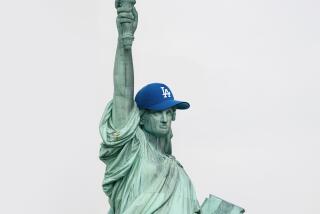CAMDEN YARDS: BALLPARK FOR ALL-TIME
- Share via
“It’s a combination of 100 years of baseball and baseball in the ‘90s. I’ve never seen a nicer park.”
--Tony LaRussa, Oakland Athletics manager
When a fan from Phoenix walked into Oriole Park at Camden Yards for the first time, he expected to see Babe Ruth step to the plate.
Baltimore’s new ballpark, which opened last season, is a blend of state-of-the-art technology and architecture with a baseball era gone by.
The image of the century’s early ballparks, such as Ebbets Field (Brooklyn), Forbes Field (Pittsburgh), Fenway Park (Boston) and Wrigley Field (Chicago), is clearly defined in the park’s design. At the same time, it is a modern fan’s delight. And it can seat 48,079 of them.
Situated on 85 acres on the old railroad yards near the renovated Camden Station, the site of the 64th All-Star Game was built strictly for baseball for approximately $105 million.
President Abraham Lincoln reportedly rode through Camden Station on trains after winning the presidency in 1860 and 1864. His funeral train also passed through there.
Other Camden facts, which may or may not be seen on the TV screen:
-- Camden Yards is one of eight asymmetrical parks in the major leagues. The field’s deepest point is left of dead center (410 feet from home plate). A 25-foot-high wall runs 100 feet from the right-field line toward center. The rest of the outfield fence is only 7 feet high. The field is natural grass.
-- The old Baltimore & Ohio warehouse sits behind the right-field bleachers, 432 feet from home plate. The right-field light tower is on top of its roof. The 94-year-old warehouse is the longest building on the East Coast at 1,016 feet.
-- The one-time railroad center is two blocks from Babe Ruth’s birthplace. Ruth’s father ran a cafe on the ground floor of the family residence at Conway Street and Little Paca, now center field.
-- Two major electronic information centers sit on the center field scoreboard: a Sony JumboTRON video board and an incandescent lamp matrix game-in-progress board built by Daktronics Inc.
-- Another electronic scoreboard in the right-field wall gives scores of up to 16 games at a time, via SportsTicker, a computerized service that keeps inning-by-inning tabs on all major league games. There are two auxiliary scoreboards for fans who do not face center field.
-- A large double-faced clock can be read from inside the ballpark and in downtown Baltimore. The main scoreboard system also supports two weather-vane Oriole birds that show the direction of the wind.
More to Read
Go beyond the scoreboard
Get the latest on L.A.'s teams in the daily Sports Report newsletter.
You may occasionally receive promotional content from the Los Angeles Times.










